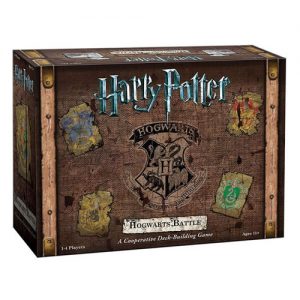 Due in August from USAopoly is Harry Potter Hogwarts Battle: A Cooperative Deck-Building Game. The game has players adopting the roles of Harry, Hermione, Ron, and Neville to combat a series of villains infiltrating Hogwarts Castle. Each has their own deck of cards, to which they’ll add spells, magical items, and other characters.
Due in August from USAopoly is Harry Potter Hogwarts Battle: A Cooperative Deck-Building Game. The game has players adopting the roles of Harry, Hermione, Ron, and Neville to combat a series of villains infiltrating Hogwarts Castle. Each has their own deck of cards, to which they’ll add spells, magical items, and other characters.
Hogwarts Battle comes with a game board, health tracker boards, dice, card boxes, and 245 cards at a suggested retail price of $50.
[5/11/2016] Note: The information above was gleaned from the websites of BBCW Distributors, CoolStuffInc, and BoardGameGeek, who may have released the information early. It has not been confirmed by the publisher.
- Comments Off on Harry Potter Deck-Building Game
Build the Ultimate Deck with Deck Building: The Deck Building Game
05 Aug
Posted by Lory Gilpatric as Card Games
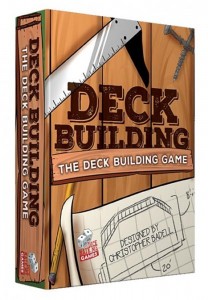 “Deck Building: The Deck Building Game combines the thrill of building your deck with the excitement of building your deck.”
“Deck Building: The Deck Building Game combines the thrill of building your deck with the excitement of building your deck.”
Are you confused yet?
In this card game for two players, you are competing against your neighbor to build the ultimate front porch (or back patio, if you wish). You’ll need some tools, materials, and some funds to create your ideal deck.
Players buy cards from the general deck using their pre-built three-card hand. Once you’ve got enough cards to get started, you can lay down planks, build stairs or railings, and stain your wood.
Staining wood keeps your opponent from being able to play a rotten plank onto your pretty new deck.
The game ends when one player runs out of cards or when the general deck is gone. However, the player to end his or her hand is not necessarily the winner. Your score is tallied by how many planks and ornaments are played, minus the number of rotten planks that are present.
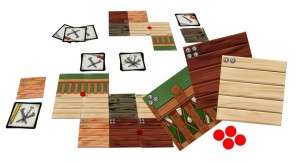 Deck Building: The Deck Building Game was funded on Kickstarter in April of 2015. It is now available to the general public for $10 through Greater Than Games. You can order it online, or head to your local board game shop and ask them to order you a copy today (if they don’t already have some in stock, of course).
Deck Building: The Deck Building Game was funded on Kickstarter in April of 2015. It is now available to the general public for $10 through Greater Than Games. You can order it online, or head to your local board game shop and ask them to order you a copy today (if they don’t already have some in stock, of course).
- Comments Off on Build the Ultimate Deck with Deck Building: The Deck Building Game

One of the Kickstarter projects that has caught my attention is the Miskatonic School for Girls deck building game. Clearly, it’s caught the attention of others too. It’s already funded at $35,000 with 24 days still to go! Three things in particular I noticed about the project: the quirky Lovecraftian girls-school theme, the idea of building your opponents’ decks, and the people involved in developing the game.
Miskatonic School for Girls is a card game in which the players are rival houses in a girls boarding school. The students in this school are all normal but the faculty are creatures and cultists, whose true educational goal is to drive the girls insane. During the course of the game, players add students to their own deck and faculty to the decks of the other players. The last house with any sanity is the winner.
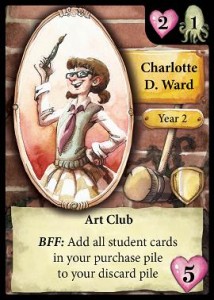
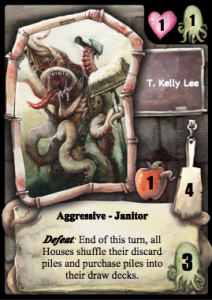
Leading the design and development of Miskatonic School for Girls is Luke Peterschmidt, a game industry veteran with credits that include the L5R and Guardian CCGs and Bakugan. Kenneth Hite advised the team on the Cthulhu mythos.
I asked Luke recently where he got the idea for such an unusual game.
The game started out as a Mechanic concept—to make a deck building game where you built your opponent’s deck. The early version was really generic, but as I developed the mechanic, I knew the property on it would need to feel like one where you are slowly losing as opposed to building up a win. From there it was a short jump to something Miskatonic-ee. I wanted to go with a funny theme because I like them, and also because I think a game like this lends itself to it. In the end, the Girls School angle seemed to really fit—and if you know Lovecraft’s thoughts on women, it makes it even funnier!
With more than 600 backers and three times the needed funding, the Kickstarter route certainly seems to have worked for this game. However, with Luke’s background in the industry, I wondered why he didn’t pursue a more traditional approach to publishing.
I have a job that I do for a living. Lately, this has been helping toy companies with TV-based games. This keeps me pretty busy, so I didn’t want to start a full featured game company again – those things take a lot of time to do right. Instead, I just wanted to do a product with people I like. Kickstarter is ideal for that. The success of the project is throwing some wrenches in that plan as these things take on a life of their own. Luckily the team we’ve put together now can handle things like in-store distribution, international translated versions, etc… without too much extra time. I don’t think you’ll see us at trade shows and such, but you will be able to get the product at retail stores eventually.
 In fact, it turns out that Miskatonic School for Girls is being published under the company name, Fun to 11.
In fact, it turns out that Miskatonic School for Girls is being published under the company name, Fun to 11.
Fun to 11 is a small group of like-minded folks with game industry experience. Jay Hernishin is the graphic designer—I worked with him eons ago on my very first CCG design, Guardians. I’ve used him in my other work since then as well, he and his wife Susie are top notch designers and we just “get” each other. They know how to tell me my idea is terrible in a way that leaves me laughing. Kai Nesbit and David Freeman are two guys I used to work with at Sabertooth Games. They are handling all the printer and distribution type stuff, which is pretty easy for them as they are not only experienced, but they have their own company called Cipher Games which has all of those relationships. David is also an excellent game designer and hopefully, we’ll do one of his product soon too. Other than that, I have an employee name Rob Noss who helps me with everything I work on (both Fun to 11, and other Geek Dynasty stuff). It’s a small dispersed team with clear rolls and responsibilities.
We have tons of ideas as to what’s coming next. As always, more ideas than time sadly… We really want Fun to 11 to be the thing that lets us make what WE want to make. If we’re at dinner one night and someone has a crazy idea, we want the ability to say “let’s do it!” not “what a great idea, too bad I’m busy.” Some projects will be big ones like the MSfG, and others might be some oddball $3 role-play accessory—who knows. And that extends to outside ideas too. We are totally willing to work with other designers who have ideas as well if we grock the concept. We just want to make cool stuff. Hopefully, we’ll have our second thing up on Kickstarter early next year, but first we have to focus on the production of MSfG and making sure we show all the backers and players how much we appreciate their support. Literally, this product would not have ever seen the light of day if we didn’t get the Kickstarter funding.
As to how this project compares to working for a company like Spin Master on Bakugan, Luke explained:
Nothing can compare to Bakugan. That thing was a generation defining product (muck like Pokemon was). It was an amazing honor to get to contribute to it, and to meet so many fans at mall events and other Bakugan things. The team was amazing, and very large. MSfG is a different experience altogether. It’s me making sure I don’t loose touch with my roots and doing a product in a small team environment with no expectations of financial reward. It’s a reminder to me that I got into game design to make games, and that doing so is a fun way to spend free time!
The pledge period for Miskatonic School for Girls ends December 5th.
Trending
- Massdrop.com
- Oh the Irony—Illuminati Card Game Continues to Inspire Conspiracy Theorists
- Footprints, an Educational Ecology Game
- USPS Adds Board Game Flat Rate Box
- Home
- Baila, the Estonian Drinking Card Game
- Crystal Caste Wins Dice Patent Suit Against Hasbro
- Hasbro and Mattel Merger?
- Are Board Games Dangerous?
- Board Games Based on Hindu Mythology
Archives
Most Popular Articles
- Oh the Irony—Illuminati Card Game Continues to Inspire Conspiracy Theorists
- The 20 Most Valuable Vintage Board Games
- The Truth About Dominoes On Sunday in Alabama
- Sequence Game, and Variants
- USPS Adds Board Game Flat Rate Box
- Baila, the Estonian Drinking Card Game
- The 13 Most Popular Dice Games
- Are Board Games Dangerous?
- Guess Who? The Naked Version
- What Happened to the Jewel Royale Chess Set?
Recent Posts
- Toy Fair 2019—Breaking Games
- Talisman Kingdom Hearts Edition
- Toy Fair 2019—Winning Moves
- Toy Fair 2019—Games Workshop
- Toy Fair 2019—Star Wars Lightsaber Academy
- Toy Fair 2019—Stranger Things Games
- Toy Fair 2019—HABA
- Licensing Roundup
- Game Bandit
- 2018 A Difficult Year For Hasbro But Not For D&D Or MtG
Recent Comments
- on Toy Fair 2019—Winning Moves
- on Game Bandit
- on Second Look—Dungeons & Dragons Waterdeep Dragon Heist
- on Crowdfunding Highlights
- on Beyblade SlingShock
- on Game Bandit
- on Game Bandit
- on Watch This Game!, the Board Game Review Board Game
- on Second Look—Vampire: The Masquerade 5th Edition
- on Palladium Books Loses Robotech IP License, Cancels Five-Year-Overdue Robotech RPG Tactics Kickstarter




